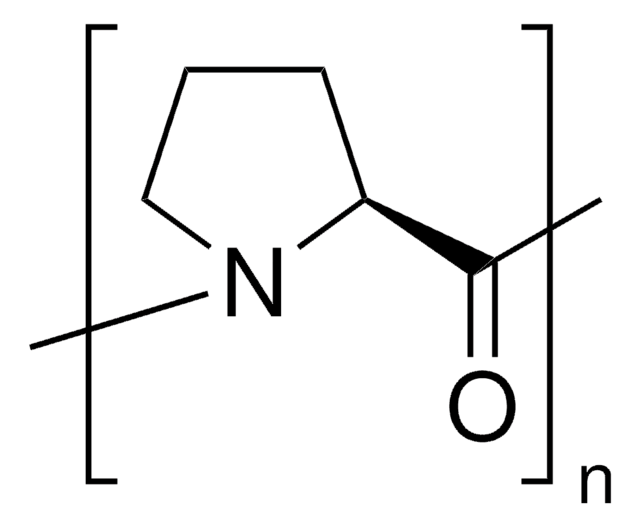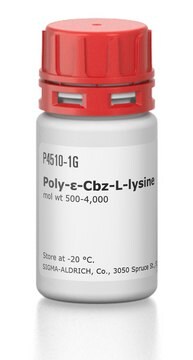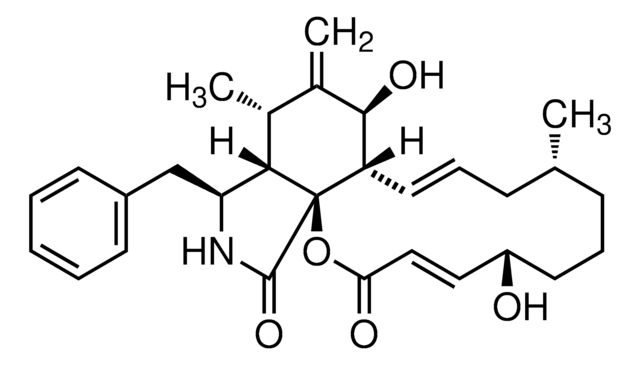Key Documents
P2254
Poly-L-proline
suitable for ligand binding assays, Mol wt 1,000-10,000
Synonim(y):
L-Proline homopolymer
About This Item
Polecane produkty
product name
Poly-L-proline, mol wt 1,000-10,000
Postać
powder
masa cząsteczkowa
1,000-10,000
metody
ligand binding assay: suitable
kolor
white
temp. przechowywania
−20°C
ciąg SMILES
OC(=O)C1CCCN1
InChI
1S/C5H9NO2/c7-5(8)4-2-1-3-6-4/h4,6H,1-3H2,(H,7,8)
Klucz InChI
ONIBWKKTOPOVIA-UHFFFAOYSA-N
Szukasz podobnych produktów? Odwiedź Przewodnik dotyczący porównywania produktów
Zastosowanie
- Highly sensitive and selective electrochemical sensor for simultaneous determination of gallic acid, theophylline and caffeine using poly(l-proline) decorated carbon nanotubes in biological and food samples.: This study presents an innovative electrochemical sensor that utilizes poly-L-proline decorated carbon nanotubes for the simultaneous detection of gallic acid, theophylline, and caffeine. This sensor demonstrates high sensitivity and selectivity, making it suitable for applications in both biological and food samples (Aschemacher NA et al., 2024).
- Water-assisted and protein-initiated fast and controlled ring-opening polymerization of proline N-carboxyanhydride.: This research explores the water-assisted and protein-initiated ring-opening polymerization of proline N-carboxyanhydride, leading to the rapid and controlled synthesis of poly-L-proline. The study highlights the method′s efficiency and potential for producing high-quality poly-L-proline for various applications (Hu Y et al., 2022).
- Phosphorylation of the actin-binding protein profilin2a at S137 modulates bidirectional structural plasticity at dendritic spines.: This study examines the role of poly-L-proline regions in the actin-binding protein profilin2a, specifically focusing on its phosphorylation at S137. The findings reveal how these modifications impact the structural plasticity of dendritic spines, providing insights into neuronal function and plasticity (Cornelius J et al., 2023).
- A structural model of the profilin-formin pacemaker system for actin filament elongation.: This paper presents a structural model involving poly-L-proline regions within the profilin-formin complex, which acts as a pacemaker for actin filament elongation. The study offers a detailed understanding of the molecular mechanisms driving actin dynamics and cellular movement (Schutt CE et al., 2022).
Działania biochem./fizjol.
Komentarz do analizy
Inne uwagi
Kod klasy składowania
11 - Combustible Solids
Klasa zagrożenia wodnego (WGK)
WGK 3
Temperatura zapłonu (°F)
Not applicable
Temperatura zapłonu (°C)
Not applicable
Środki ochrony indywidualnej
Eyeshields, Gloves, type N95 (US)
Certyfikaty analizy (CoA)
Poszukaj Certyfikaty analizy (CoA), wpisując numer partii/serii produktów. Numery serii i partii można znaleźć na etykiecie produktu po słowach „seria” lub „partia”.
Masz już ten produkt?
Dokumenty związane z niedawno zakupionymi produktami zostały zamieszczone w Bibliotece dokumentów.
Klienci oglądali również te produkty
Produkty
Humankind has utilized protein materials throughout its existence, starting with the use of materials such as wool and silk for warmth and protection from the elements and continuing with the use of recombinant DNA techniques to synthesize proteins with unique and useful properties.
Nasz zespół naukowców ma doświadczenie we wszystkich obszarach badań, w tym w naukach przyrodniczych, materiałoznawstwie, syntezie chemicznej, chromatografii, analityce i wielu innych dziedzinach.
Skontaktuj się z zespołem ds. pomocy technicznej











